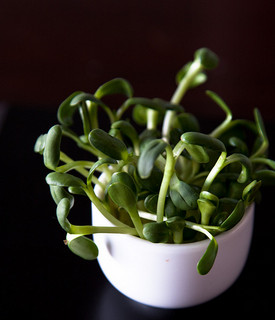When I read Karen Knowler’s article on growing indoor salad greens (reprinted with permission below) I immediately thought what a good addition they would make to a Fall Body Cleanse Detox.
While the majority of people only think of going on a detox diet in the New Year many authorities say that your body’s capacity for detoxification is greatest at the two equinoxes, spring and fall.
Cleansing your body before winter sets in will help boost your immune system in time to fight off all those pesky winter bugs. All the delicious and colorful fall fruits and vegetables make ideal detox food but fresh green salad produce becomes more scarce and expensive, so why not grow your own indoor salad greens instead?
Leafy greens and cereal grasses are a rich source of vital nutrients needed to boost the detox pathways. They are full of vitamins, minerals, antioxidants and chlorophyll, which has a highly alkalizing effect on the body that in turn encourages detoxification. Living foods and Wheat grass juice were pioneered by Ann Wigmore, co-founder of the Hippocrates Health Institute, for detoxing and healing the body.
Read on to discover how easy and cheap it is to grow your indoor salad greens for your Fall Body Cleanse Detox.
“The Raw Fooder’s Guide to Indoor Greens Part 1: What and Why
Growing indoor greens is a fun and nutritious way to bring the freshest green plants into your life. Here is a quick introduction to growing your own wheat grass, sunflower seeds, pea greens, buckwheat greens and more.

What are indoor greens?
“Indoor greens” is the term typically used to describe wheatgrass, barley grass, spelt grass, kamut grass, sunflower greens, buckwheat “lettuce” and pea greens – all of which can be grown in your own home. They can be grown in trays or automatic sprouters, and can be grown in soil or hydroponically.
Why grow indoor greens?
Along with sprouts, indoor greens are second to none when it comes to adding fresh green foods to your daily diet, and what’s more, like sprouts, they’re super-cheap and easy to grow. As foods go, they get an A+ grade in every department, and as is clearly evident by their lusciously green appearance, they are exceedingly high in chlorophyll, which most people eat far too little of. From an aesthetic point of view they look stunning in your kitchen, especially when set amongst a counter top full of colourful fresh fruits.
What do I need to grow indoor greens?
You don’t need any fancy equipment to grow your own greens. If you choose to there are automatic sprouters and wheatgrass kits on the market, but to get started you only need some simple basic equipment. Start with a container to sprout in, something to drain the water through such as a piece of muslin or netting, a seedling tray or two from any good gardening or DIY store (with or without holes) and some good quality soil or compost, ideally organic. Good soil from your garden can be sufficient to start you off but it may not be the best quality. If that’s the case, you could add some kelp powder or a good mineral-rich food to feed the soil.
Getting started
Greens are really easy to grow. I recommend starting with sunflower greens and/or wheatgrass. If you prefer to start with just one type and would like to eat rather than drink the result, then go for sunflower greens; if you’d rather drink it start with wheatgrass, as the only way you can consume this is by juicing it. Pea greens are the next easiest, followed by buckwheat greens, or buckwheat lettuce as it is also known.

How can I use indoor greens?
Most indoor greens can be eaten as is, added to salads, rolled up into wraps or juiced with other vegetables. The human body is not capable of digesting grasses so wheatgrass (including spelt grass, kamut grass and barley grass) should only be juiced and not eaten. It is traditionally drunk straight on its own in small shots of 2-4 oz shots, but if you aren’t a fan of it as it comes, you can mix it with other vegetable juice to make it more palatable.
Learning to grow your own indoor greens opens opportunities to grow your very own truly live food that is bursting with flavour and nutrition. It’s cheap, easy and fun to do, the most nutritious food you can eat and you don’t need a garden to do it. What’s not to love?
Coming next week: The Raw Fooder’s Guide to Indoor Greens Part 2: Varieties of Greens
That’s the end of Karen’s article. These are my notes:
Wheatgrass has to be juiced is a special auger style juicer so if you have a normal juicer or blender sunflower and pea greens (pea shoots) are good for a detox juice or blending into a Green Smoothie. Juice or blend them with some spinach or kale, celery, fresh root ginger, and a green apple or pear. The pea shoots give the drink a nice sweet finish.
Here’s a recipe for a tasty pea green salad.
1 large handful pea greens
¾ cup diced mango
1 avocado, diced
½ orange or yellow bell pepper, chopped
Make a dressing with about 1/8 cup orange juice, 1 Tbsp extra virgin olive oil and 1 tsp lemon juice.
It only takes about 7 days to grow pea and sunflower greens so you will still have time to grow some for your fall body cleanse diet.
If you are looking for inspiration and guidance around going and staying raw Karen Knowler, The Raw Food Coach, has provided 4 training calls here.
Picture credits:
Sunflower Shoots by Pauline Mak
Pea Shoots by Benketaro




What an inspiring post…I am going to plant some wheatgrass…this post has given me the little booster that I needed.
Hi Claire,
Glad you found it useful. Watch out for part 2 next week.
Good health
Sandy